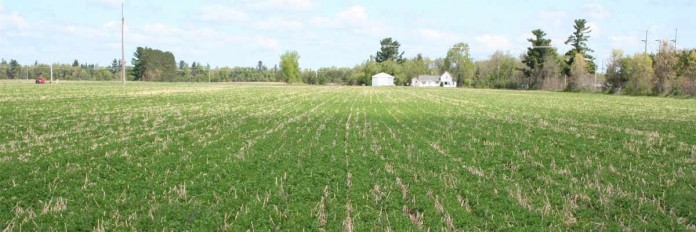Everyone has noted that the rains the past few years have been especially unpredictable.
This past spring (2018) was warm and wet, and it didn’t quit raining until about July.
When it did stop raining, we went weeks with no rain and when it did finally rain again, we received maybe an hour of very heavy downpours.
During these very heavy downpours, how can you ensure that the water is going to get into your ground and be useful to your crops, rather than run off into the road ditch?
How about implementing the use of cover crops?
The idea of cover crops is brought up often, but for anyone who does not know, a cover crop is a plant that is planted between your cash crop rotation to stabilize soil, build nutrients, suppress weeds and allow soil biology to remain active.
These crops can be anything from cereal rye grass planted late in the season to sunflowers and buckwheat planted during the summer.
The biggest thing cover crops do is hold soil in place.
Most conservationists push cover crops to reduce erosion in fields, but they do so much more.
Soil moisture is the one variable that we can influence in our agricultural system.
We can’t just make it rain when we need it, so how can we influence it with cover crops?
Cover crops help build your soil profile and open channels to allow that heavy rain to quickly infiltrate into the ground where it is useful to plants.
A bare tilled field when hit with a heavy rain will not allow water to infiltrate.
The top layer of soil is so compacted and hard that it will cause the water to run off before it has any time to infiltrate to the plants’ roots.
As it runs off, it takes top soil and nutrients with it right into our lakes, streams and rivers.
Your cover crops usually have deep rooted systems that will go further into the soil and help create channels for your cash crop’s roots to follow the next growing season.
Certain plants, such as daikon radishes, will break up compaction that has been caused by years of tillage.
When you have broken these compacted layers, you give your cash crops the opportunity to harvest water and nutrients from an even broader area of soil.
Another technique is to plant your cash crop, such as corn, directly into your cover crop, then spray it.
The remaining cover crop residue will not only hold your soil in place but also shade it.
Why would shaded ground below your corn matter? Well, it would keep your soil moist all the while lowering the temperature of the soil.
This, in turn, would put less stress on your crop and increase your yield.
Long-term cover cropping is also shown to help increase your soil organic matter, which increases the moisture-holding capacity of your crop ground.
So by adding a cover crop into your rotation, you can begin to influence many things.
Not only will you be keeping the topsoil and nutrients you have on your fields, you can add nutrients if you plant a legume into your cover crop mix.
You will begin to build up your organic matter and increase the infiltration of water in your soil.
All these factors can help increase your yield. If continued year after year, it will begin to show in your wallet as well as your soil tests.













